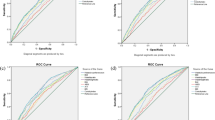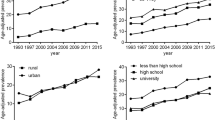Abstract
Objective: To evaluate waist circumference (WC) as a screening tool for obesity in a Caribbean population. To identify risk groups with a high prevalence of (central) obesity in a Caribbean population, and to evaluate associations between (central) obesity and self-reported hypertension and diabetes mellitus.
Design: Cross-sectional.
Setting: Population-based study.
Subjects: A random sample of adults (18 y or older) was selected from the Population Registries of three islands of the Netherlands Antilles. Response was over 80%. Complete data were available for 2025 subjects.
Interventions: A questionnaire and measurements of weight, height, waist and hip.
Main outcome measurement: Central obesity indicator (WC ≥102 cm men, ≥88 cm women).
Results: WC was positively associated with age (65–74 y vs 18–24 y) in men (OR=7.7, 95% CI 3.4–17.4) and women (OR=6.4, 95% CI 3.2–12.7). Women with a low education had a higher prevalence of central obesity than women with a high education (OR=0.5, 95% CI 0.3–0.7). However, men with a high income had a higher prevalence of a central obesity than men with a low income (OR=1.7, 95% CI=1.1–2.6). WC was the strongest independent obesity indicator associated with self-reported hypertension (OR=1.7, 95% CI 1.4–2.0) and diabetes mellitus (OR=1.6, 95% CI 1.3–1.9).
Conclusion: The identified risk groups were women aged 55–74 y, women with a low educational level and men with a high income. WC appears to be the major obesity indicator associated with hypertension and diabetes mellitus.
Sponsorship: Island Governments of Saba, St Eustatius and Bonaire, the Federal Government of the Netherlands Antilles, Dutch Directorate for Kingdom relationships.
This is a preview of subscription content, access via your institution
Access options
Subscribe to this journal
Receive 12 print issues and online access
$259.00 per year
only $21.58 per issue
Buy this article
- Purchase on Springer Link
- Instant access to full article PDF
Prices may be subject to local taxes which are calculated during checkout
Similar content being viewed by others
References
Alberts JF, Gerstenbluth I, Halabi YT, Koopmans PC, O’Niel J & Heuvel van den WJA (1996): The Curacao Health Study, Methodology and Main Results. pp 119. Assen: Van Gorcum.
Allison DB, Paultre F, Goran MI, Poehlman ET & Heymsfield SB (1995): Statistical considerations regarding the use of ratios to adjust data. Int. J. Obes. Relat. Metab. Disord. 19, 644–652.
Conway JM, Chanetsa FF & Wang P (1997): Intraabdominal adipose tissue and anthropometric surrogates in African American women with upper- and lower-body obesity. Am. J. Clin. Nutr. 66, 1345–1351.
Deurenberg P, Yap M & van Staveren WA (1998): Body mass index and percent body fat: a meta analysis among different ethnic groups. Int. J. Obes. Relat. Metab. Disord. 22, 1164–1171.
Flegal KM, Carroll MD, Kuczmarski RJ & Johnson CL (1998): Overweight and obesity in the United States: prevalence and trends, 1960–1994. Int. J. Obes. Relat. Metab. Disord. 22, 39–47.
Ganzeboom HBG, de Graaf PM & Treiman DJ (1992): A standard international socioeconomic index of occupational status. Soc. Sci. Res. 21, 1–56.
Gerstenbluth I, Alberts JF, te Velde B & Leerink CB (1995): De prevalentie van chronische aandoeningen op Curaçao (in Dutch), In Results of the Curacao Health Study and Policy Implications. pp 19–25. Netherlands Antilles: ISOG 2000 Curacao.
Gerstenbluth I, Alberts JF, Huirne JAF & Smits IMH (1996): Prevalentieschattingen van chronische aandoeningen op Curacao: zelfrapportage versus huisartsenregistratie (in Dutch). Tijdschrift voor Sociale Gezondheidszorg 74, 184–190.
Grol MEC, Eimers JM, Alberts JF, Bouter LM, Gerstenbluth I, Halabi Y, van Sonderen E & van den Heuvel WJA (1997): Alarmingly high prevalence of obesity in Curaçao: data from an interview survey stratified for socioeconomic status. Int. J. Obes. Relat. Metab. Disord. 21, 1002–1009.
Gulliford MC (1994): Health and health care in the English-speaking Caribbean: a British public health physician's view of the Caribbean. J. Pub. Health Med. 16, 263–269.
Gutierrez-Fisac JL, Regidor E & Rodriguez C (1995): Economic and social factors associated with body mass index and obesity in the Spanish population aged 20–64 years. Eur. J. Pub. Health 5, 193–198.
Han TS, Leer EM van, Seidell JC & Lean MEJ (1995): Waist circumference action levels in the identification of cardiovascular risk factors: prevalence study in a random sample. Br. Med. J. 311, 1401–1405.
Hill JO, Sidney S, Lewis CE, Tolan K, Scherzinger AL & Stamm ER (1999): Racial differences in amounts of visceral adipose tissue in young adults: the CARDIA (Coronary Artery Risk Development in Young Adults) Study. Am. J. Clin. Nutr. 69, 381–387.
Lackland DT, Orchard TJ, Keil JE, Saunders Jr DE, Wheeler FC, Adams-Campbell LL, McDonald RH & Knapp RG (1992): Are race differences in the prevalence of hypertension explained by body mass and fat distribution? A survey in a biracial population. Int. J. Epidemiol. 21, 236–245.
Lean MEJ, Han TS & Morrison CE (1995): Waist circumference as a measure for indicating need for weight management. Br. Med. J. 311, 158–161.
Luke A, Durazo-Arvizu R, Rotimi C, Prewitt TE, Forrester T, Wilks R, Ogunbiyi OJ, Schoeller DA, McGee D & Cooper RS (1997): Relation between body mass index and body fat in black population samples from Nigeria, Jamaica, and the United States. Am. J. Epidemiol. 145, 620–628.
Molarius A & Seidell JC (1998): Selection of anthropometric indicators for classification of abdominal fatness—a critical review. Int. J. Obes. Relat. Metab. Disord. 22, 719–727.
Molarius A, Seidell JC, Sans S, Tuomilehto J & Kuulasmaa K (1999): Varying sensitivity of waist action levels to identify subjects with overweight or obesity in 19 populations of the WHO MONICA Project. J. Clin. Epidemiol. 52, 1213–1214.
Monteiro C (2000): The epidemiological transition in Brazil, In WHO Scientific publications No. 576 (Obesity and Poverty: a New Public Health Challenge). pp 67–76. Washington: PAHO.
Mootz M & van den Berg J (1989): Indicatoren voor gezondheidstoestand in de CBS-gezondheidsenquête (in Dutch). Maandbericht Gezondheid (CBS) 89, 4–10.
Okosun IS, Liao Y, Rotimi CN, Choi S & Cooper RS (2000): Predictive values of waist circumference for dyslipidemia, type 2 diabetes and hypertension in overweight white, black, and Hispanic American adults. J. Clin. Epidemiol. 53, 401–408.
Okosun IS, Choi S, Dent MM, Jobin T & Dever GE (2001): Abdominal obesity defined as a larger than expected waist girth is associated with racial/ethnic differences in risk of hypertension. J. Hum. Hypertens. 15, 307–312.
Rankinen T, Kim S-Y, Pérusse L, Després J-P & Bouchard C (1999): The prediction of abdominal visceral fat level form body composition and anthropometry: ROC analysis. Int. J. Obes. Relat. Metab. Disord. 23, 801–809.
Seidell JC, Han TS, Feskens EJM & Lean MEJ (1997): Narrow hips and broad waist circumferences independently contribute to increased risk of non-insulin-dependent diabetes mellitus. J. Int. Med. 242, 401–406.
Seidell JC & Visscher TLS (2000): Body weight and weight change and their health implications for the elderly. Eur. J. Clin. Nutr. 54(Suppl 3), S33–S39.
Sobal J & Stunkard AJ (1989): Socioeconomic status and obesity: a review of the literature. Psychol. Bull. 105, 260–275.
SPSS Inc (1999): Guide to Data Analyses. 9th edition. Chicago: SPSS. Inc.
Visscher TLS & Seidell JC (2001): The public health impact of obesity. Annual Rev. Public Health 22, 355–375.
Wei M, Gaskill SP, Haffner SM & Stern MP (1997): Waist circumference as the best predictor of noninsulin dependent diabetes mellitus (NIDDM) compared to body mass index, waist/hip ratio and other anthropometric measurements in Mexican Americans, a 7-year prospective study. Obes. Res. 5, 16–23.
Wilks R, Bennett F, Forrester T & McFarlane-Anderson N (1998): Chronic diseases: the new epidemic. West Indian Med. J. 47(Suppl 4), S40–S44.
World Health Organisation (WHO, 1987): Obesity—classification and description of anthropometric data, In Report on WHO Consultation on the Epidemiology of Obesity. Warsaw: WHO.
World Health Organisation (WHO, 1998): Obesity: Prevention and managing the global epidemic, In Report of a WHO Consultation on Obesity. WHO/NUT/NCD/98.1. Geneva: WHO.
Acknowledgements
This study is a joint project of the Epidemiology & Research Unit of the Medical and Public Health Service of Curaçao, the Northern Centre for Health Care Research of the University of Groningen in the Netherlands, the Foundation for Promotion of Research and International Cooperation in Health Care (ISOG) in Curaçao, the Island Governments of Saba, St Eustatius and Bonaire and the Federal Government of the Netherlands Antilles. The study was co-financed by the Dutch Directorate for Kingdom relationships. The authors wish to thank Gabi Fuchs, Wim van den Heuvel and Eric van Sonderen and for their valuable contributions.
Author information
Authors and Affiliations
Contributions
Guarantor: JF Alberts.
Contributors: L Grievink was involved in the study design and analysed the data. JF Alberts coordinated the study, J O’Niel and I Gerstenbluth were involved in the study design. All authors contributed to the writing of the article.
Corresponding author
Rights and permissions
About this article
Cite this article
Grievink, L., Alberts, J., O’Niel, J. et al. Waist circumference as a measurement of obesity in the Netherlands Antilles; associations with hypertension and diabetes mellitus. Eur J Clin Nutr 58, 1159–1165 (2004). https://doi.org/10.1038/sj.ejcn.1601944
Received:
Revised:
Accepted:
Published:
Issue Date:
DOI: https://doi.org/10.1038/sj.ejcn.1601944
Keywords
This article is cited by
-
An assessment of anthropometric indices and its association with NCDs among the older adults of India: evidence from LASI Wave-1
BMC Public Health (2021)
-
Social determinants of breast cancer in the Caribbean: a systematic review
International Journal for Equity in Health (2017)
-
Body mass index, waist-hip ratio and risk of chronic medical condition in the elderly population: results from the Well-being of the Singapore Elderly (WiSE) Study
BMC Geriatrics (2016)
-
Waist circumference and risk of elevated blood pressure in children: a cross-sectional study
BMC Public Health (2011)
-
High blood pressure in urban Moroccan women from an agricultural region
Mediterranean Journal of Nutrition and Metabolism (2011)



